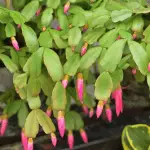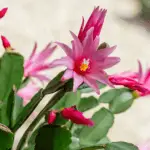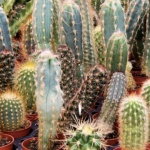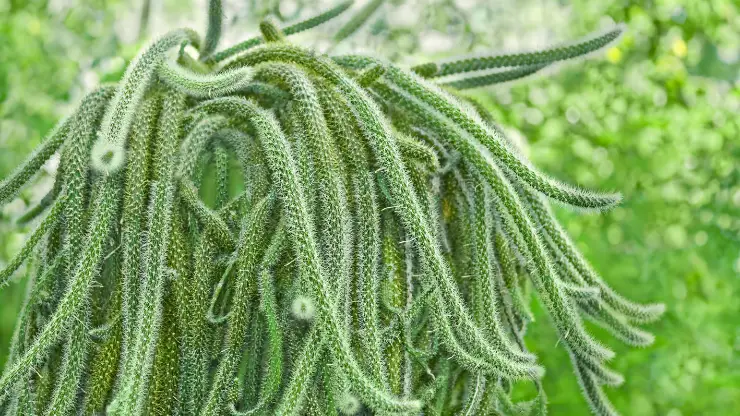
Rat tail cactus (Disocactus flagelliformis) is an epiphytic cactus with long cylindrical stems densely covered in white, orange, or yellow spines. This cactus is fast-growing when given lots of light, and the stems can reach up to 4 feet (1.2 meters) long.
Rat tail cactus is highly prized for these attractive rope-like stems that cascade from their pot or hanging basket. If you keep this cactus happy, you’ll also be rewarded with colorful tubular flowers in spring. They come in pink, purple, and bright orange.
In this post, I’ll cover all aspects of how to care for rat tail cactus to keep it growing fast and blooming abundantly in your home.
How to Care for Rat Tail Cactus
Rat tail cactus is not hard to grow, but it does have high light requirements. As long as you can provide enough sunlight, you can keep this cactus thriving for many years. Here’s a brief rundown of care requirements:
- WATER: Moderate; water when the top 1 inch (2.5 cm) of soil dries out
- HUMIDITY: Low
- FEEDING: Every two weeks during growing season
- LIGHT: Direct sun from a south-facing window
- TEMPERATURE: 60 – 80 degrees F (15 – 27 degrees C)
- SAFETY: Non-toxic, but watch out for the sharp spines
- DIFFICULTY: Easy
These are basic care guidelines for rat tail cactus. Keep reading for more in-depth information including potting, propagation, maintenance, flower care and more.
Water
In spring through fall, water rat tail cactus any time the potting soil becomes dry to a depth of 1 inch (2.5 cm). Insert your finger directly into the soil up to your first knuckle. If the soil feels dry, it’s time to water. If it still feels moist, check again the next day.
In winter when the plant is resting, water less frequently – just enough to keep the potting medium from drying out completely. Depending on how dry the air is in your home, this can vary from once a week to once every two weeks.
Humidity
Rat tail cactus does not require any supplemental humidity. It’s an easy-to-grow cactus that thrives in dry air. It performs just fine in most household conditions, even during dry winters.

Fertilizer
Feed your rat tail cactus once every two weeks in spring through fall. Use any balanced houseplant fertilizer (or a fertilizer formulated for cacti and succulents) diluted to half strength. Don’t fertilize during winter when the plant is resting.
My favorite fertilizer for cacti and succulents is this one by Cute Farms. I’ve had very good success with it on my own plants. But you don’t have to buy a special fertilizer. Rat tail cactus is fine being fed with your regular houseplant food too.
Light
Rat tail cactus need full, direct sunlight from a south-facing window to really thrive and produce lots of flowers. It will tolerate a half-day of sun from an east- or west-facing window, but it might not produce many flowers. In low light, it won’t bloom at all.
You can also place this cactus outdoors in a partially shaded location during spring and summer. The more bright light it receives in fall and winter, the more blooms you’ll get in spring.
Temperature
Keep your rat tail cactus in a warm room where temperatures stay between 70 to 80 degrees F (21 to 27 degrees C) during the day. Keep nighttime temperatures between 60 to 70 degrees F (15 to 21 degrees C) for the best results.
In winter, the plant needs a rest period. During this time, keep temperatures between 55 to 65 degrees F (13 to 18 degrees C). Never allow temperatures to drop below 45 degrees F (7 degrees C), or the plant may become irreparably damaged.
Potting
The best potting soil for rat tail cactus is a 50/50 mix of ordinary potting soil and sand to improve drainage. There are many potting mixes designed for cacti and succulents on the market, but these don’t work well for rat tail cactus.
Commercial cacti mixes are mostly sand and need to be mixed 50/50 with ordinary potting soil to increase water-holding capacity. (My favorite houseplant soil is this one by Happy Frog because it contains mycorrhizal fungi and beneficial soil microbes.)
Re-pot rat rail cactus annually in late spring or early summer when flowering is done. Shift to a container with a diameter of 2 inches (5 cm) larger than the current pot. Older plants will need to be potted less often. After a few years, you can usually wait a couple years between.
Propagation
Rat tail cactus propagation is easy. This plant is a natural creeper that’s adapted to growing along rocky ledges in the desert. It develops little roots along its stems. Simply take and root stem cuttings to create new plants.
Take 6 inch (15 cm) stem cuttings from the ends of stems in early summer. Allow the cut ends to dry for two days, and then place them in damp potting mix to root. Use a 50/50 mix of potting soil and sand, as described in the “Potting” section above.
Maintenance
Rat tail cactus blooms in spring. Each flower lasts two to three days, and blooms are produced for about two months. When flowers fade after a few days, deadhead them by gently pulling them off the plant. Again, wear gloves to avoid the sharp spines!
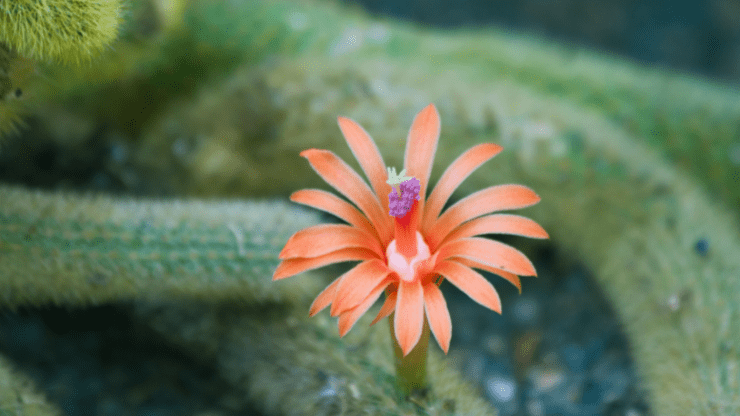
Rat Tail Cactus Problems
Here are some common problems indoor gardeners often have when learning how to care for rat tail cactus, plus solutions on how to fix them.
- Rat Tail Cactus Turning Brown – If your rat tail cactus is turning brown, the problem is most likely under-watering. Make sure to water any time the top 1 inch (2.5 cm) of soil dries out in spring through fall. In winter, water enough to keep the soil from drying out completely. For more help, see this post: Why is My Cactus Turning Brown? 5 Causes & Solutions!
- Failure to Flower – If your rat tail cactus is not producing flowers, this is most likely due to insufficient light. This plant needs lots of bright, direct sunlight to produce blooms. Place in a south-facing window year-round for the best results.
Related Questions
Here are some frequently asked questions related to rat tail cactus care that you might find helpful (plus my answers to them).
How Do You Take Care of a Rat Tail Cactus?
Rat tail cactus is easy to grow. It needs lots of bright, direct light from a south-facing window, water when the top 1 inch (2.5 cm) soil dries out, and feeding once every two weeks during spring through fall. Reduce watering in winter and do not feed in winter. Re-pot once a year as needed.
How Often Should You Water a Rat Tail Cactus?
Water rat tail cactus any time the top 1 inch (2.5 cm) of the potting medium dries out. The time between watering varies depending on the temperature and humidity in your home. I typically water mine once or twice a week during active growth.
Check soil moisture daily by inserting your finger into the soil. If it feels dry, give the plant water. If it feels moist, check back the next day.
Can Rat Tail Cactus Take Full Sun?
Yes, rat tail cactus loves lots of bright, direct sunlight. It performs best in a south-facing window when grown indoors as a houseplant. It can also be placed outdoors in direct sun or a partially shaded area during the late spring and summer.
Where to Buy Rat Tail Cactus
You may be able to find rat tail cactus for sale at local nurseries or garden centers in early spring and summer. If you want a certain color of flower, make sure to buy it in bloom. If you can’t find it locally, consider checking listings on Etsy.
I always buy my more exotic and hard-to-find plants on Etsy. I love purchasing from small growers because they typically have better quality plants and care more about their reputation than large nurseries that sell online. Plus, you can find cool varieties you might not see locally.
Click here to see the current Etsy listings for Rat Tail Cactus. Good luck and happy growing!

